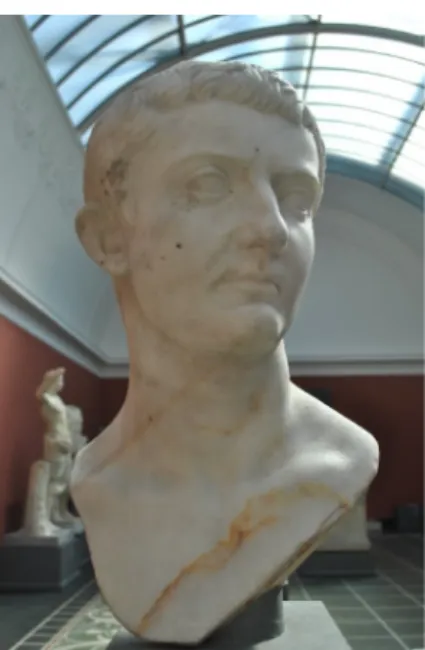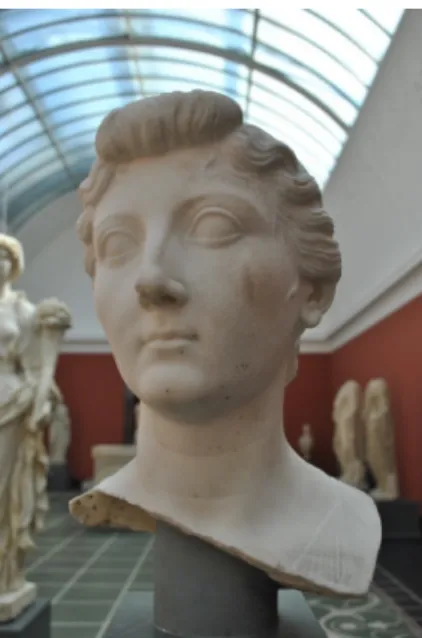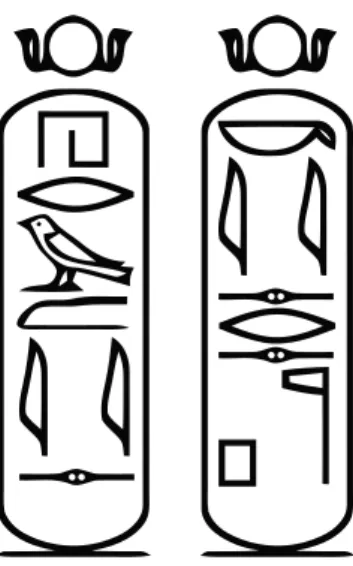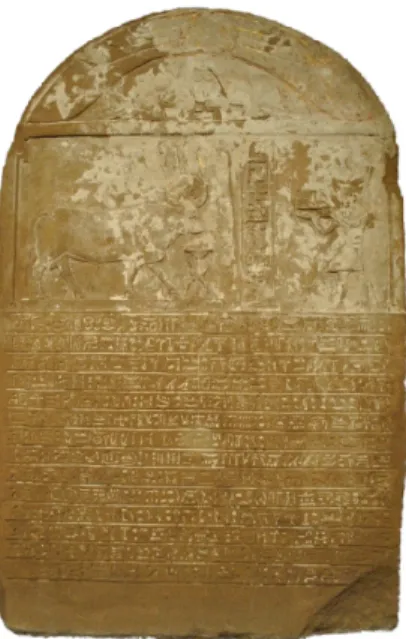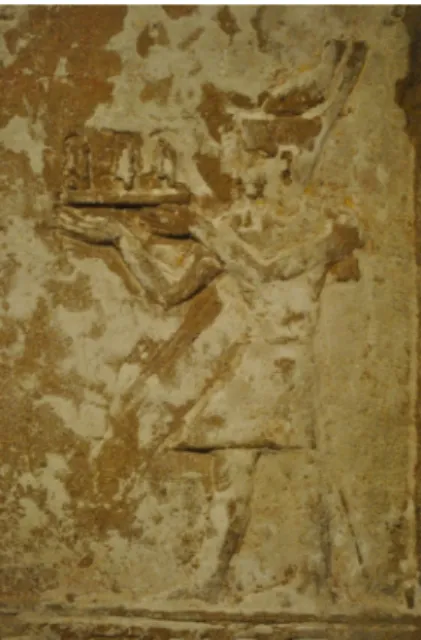Christoph Klose, Lukas C. Bossert, William Leveritt (eds.) | Fresh Perspectives on Graeco-Roman Visual Culture.
Proceedings of an International Conference at Humboldt-Universität, Berlin, 2nd–3rd September 2013 | 2015 | urn:nbn:de:kobv:11-100229177
Augustus: Caesar and god.
Varying Images of the first Roman Emperor
Jodie Martyndale-Howard The University of Nottingham
W
hy is it that Rome’s first Emperor can be seen to adorn Egyptian art and architecture as Pharaoh throughout the province? How might the context of such images help our understanding of the population make-up and rea- sons behind such portrayals? These are the questions I wish to answer through exploring the varying images of the first Roman emperor.Whenever Augustus is mentioned images of power such as the Prima Porta are first to come to our minds.1As one of the most well-known Imperial statues it is often our first thought regarding portraits of the young, militarily successful leader of the Roman world.
It is this image which has been seen throughout modern scholarship as the epitome of the traits Augustus wished his subjects to see, and therefore the one which resonates most strongly in our minds as the defining image of the emperor.2
Yet various scholars who address provincial images pay little or no attention to Egypt and the array of portrayals available.3This may be because of the peculiar nature of Egypt: for some Classicists, it is Egyptologists who should be researching the images and wrestling with the complex iconographic system that had developed through centuries of Pharaonic and Ptolemaic rule; the other side believe it to be the remit of Classicists, who can use such images to understand how the province was ruled. It therefore straddles an uncomfortable – though entirely artificial – division in academic approaches.
With thanks to Will Leveritt for the rendition of the cartouches (fig. 5).
1For the purposes of this paper, references to Augustus also include the time up to 27 BC when he was still known as Octavian.
2Beard and Henderson 2001, 222.
3Erika Simon 1986 or Paul Zanker 1990.
Free standing sculpture
Prior studies on portraits often give little attention to Egypt;4 this paper distinguishes itself from the few prior studies by laying a greater emphasis on the importance of con- text. By looking at not just what the iconography of Augustus portrays, but where it comes from and who could have created it, I hope to show the need for context when examining these visual representations.
When thinking about Egypt’s art and architecture, iconic postcard vistas come to mind.
We see pyramids, vast temple complexes with giant columns and colossal statues covered in hieroglyphs. What is often forgotten in our stereotypical view of Egypt is how much of the remaining temples were actually built not by the Pharaohs of old but by the Ptolemies and Romans, who extended and recycled the traditional temples.5 This, coupled with Egypt’s new status within the empire as a province of the Roman people,6creates an ideal setting to explore how the new regime would interact with its subjects.
Before we continue, a word concerning Egyptian art and religion as well as its position within the Roman Empire is needed to be able to fully understand the context of the imagery discussed below.
Egypt was ruled for centuries by Pharaohs who were responsible for maintainingmaat (world order).7 To maintain this the Pharaoh interacted with the gods so that the cos- mos would not collapse.8This placed the Pharaoh at the centre of Egyptian life, not just religion. The conquering of Egypt by Alexander and the Ptolemies had created a ‘double- faced’ outlook:9there was the continued presence of the ‘traditional Egyptian’ Pharaoh of old, with the emergence of the new Hellenistic ruler cult. This mix of traditions, cou- pled with Egypt’s new status within the Roman Empire from 30 BC as a province,10made for a time for of both continuity and change.
* * *
So were Pharaonic images of Augustus the norm? When looking at the Meroë Head (which is on display in the British Museum in London, IN 1911,0901.1), the answer would seem to be no.11Found in modern day Sudan, it was originally set up in Egypt and taken during an Ethiopian raid at some point between 25 to 21 BC.12 Here we see a ‘typical’
portrait of the emperor.
Made of bronze, the Meroë head originates from a full length statue. The glass eyes stare back past the viewer, and above his right eye the distinctive pincer shape can be seen, showing the emperor in the Prima Porta type. His lips are together and turn slightly down, and his ears protrude out from the sides of the head. The head leans slightly to the right although there is no sign of tension in the neck muscles.
4Leading works in this area include: Bowman 1986; Dundas 1994; Dundas 2002; Holbl 2000; Holbl 2004; Porter and Moss 1951; Porter and Moss 1970.
5Finnestad 1998, 185–186; Arnold 1999, 143–144.
6Res Gestae Divi Augusti27.
7Brewer and Teeter 1999, 86.
8Dunand and Zivie-Coche 2004, 202.
9Koenen 1993, 29.
10Capponi 2005, 10.
11For reference see under thislink.
12Walker and Burnett 1981, 22.
Fig. 1:Head of Tiberius; Ny Carlsberg Glyptotek.
Photographer: Jodie Martyndale-Howard.
There are some obvious Hellenistic traits visible, particularly the tilt of the head, almost a moment ofpathos.13This leaves the question of why such an image can be found within Egypt, where Pharaonic images were the norm.
It has been suggested that the statue could have originally been set up in a temple to the imperial cult.14This would therefore suggest a Hellenistic form of monarchy. Ptolemy I Soter set up a cult to Alexander in Alexandria in around 29 BC which formed the basis of the Ptolemaic dynastic cult.15 This, coupled with the knowledge that theCaesareumwhich was started un- der Cleopatra VII was dedicated under Augustus, would suggest that such a cult existed; the Hellenising influence increases the likelihood that such images would have been set up.16This would also suggest that such a cult existed in both Upper and Lower Egypt. This image of Augustus can there- fore be seen as a continuation of the ruling Ptolemaic dynastic cult, and although Augustus may not have set this precise statue up, the evidence points to the emperor wishing to adopt the local traditions.
Images 1, 2 and 3 are all easily recognisable as Tiberius, Augustus, and Livia. They originate from Fayum (Arsinoe) and were found together in the theatre complex of the town. They form part of a dynastic commemorative group, set up around 4 AD after the adoption of Tiberius.17
Fig. 2:Head of Augustus; Ny Carlsberg Glyptotek.
Photographer: Jodie Martyndale-Howard.
The Meroë Head is not the only example of a Roman/Hellenistic influenced portrait of Augustus in Egypt. Consider the three busts which can be seen on display at the Glyptotek in Copenhagen. In the marble bust of Augustus, his head faces to the right with his shoulders central, with the turning cre- ating small signs of tension in the neck muscles. There is a single wrinkle on his forehead below the pincer shape hair. This group of busts again sug- gests Hellenistic influence on the portraiture of the Roman emperor. Once more we do not have the whole picture of the statues’ context. There was no inscription found alongside the statues, so we do not know the circum- stances of their erection. However some things we do know enable us to get closer to the statue’s meaning. It is recognised that throughout provincial towns in Egypt, the imperial cult was not set up by Roman officials but by the local elite, who were trying to align themselves with the imperial fam- ily.18Therefore they represent very public display, not only of the adoption of Tiberius, but of a magnate accepting this adoption, and recognising that Tiberius will become ruler after Augustus. Given that these images origi- nate from Fayum, perhaps it is not that surprising that they are Romanised, especially when one considers the most famous examples of art from this region, the mummy portraits.
13For detailed discussion of Hellenistic ruler portraiture, see Smith 1988.
14Walker and Burnett 1981, 22.
15Koenen 1993, 46. 50; Fraser 1972.
16Pfeiffer 2012, 86.
17Rose 1997, 188.
18Dunand and Zivie-Coche 2004, 251.
Fig. 3:Head of Livia; Ny Carlsberg Glyptotek.
Photographer: Jodie Martyndale-Howard.
This perhaps reflects the make-up of the society at Fayum, and suggests a Greco-Roman population rather than Egyptian. So far these two cases have highlighted what one would expect to see: Romanised images of the first emperor, along with his family. These types of portrait can be found all over the empire.
It is at this point in my discussion where Egypt takes a unique turn. For example, the full-length statue of Augustus from Karnak is an example of hybrid iconography.19There is considerable academic debate as to whether this is Augustus or an earlier Ptolemy, as many think it is hard to distin- guish by looking at the hair alone, but the general consensus is that there is enough of the Prima Porta hair type visible to conclude this is Augustus.20 The statue is made from granite and is over life size at 2.80 m.21Looking at the statue in detail, it is easy to see its Egyptian influences. He wears thenemescloth headdress with theuraeus (snake) in the centre, both of which denote the statue as being a Pharaoh. Further down, he wears the traditional Egyptian kilt, theshendytwith his hands clenching folded cloth besides it. He strides out towards the viewer, left foot forward. In contrast to the sculptures already seen, the sculpting technique is different here.
Fig. 4:Unknown Pharaoh, Ny Carlsberg Glyp- totek, Copenhagen
Photographer: Jodie Martyndale-Howard.
The figure is not completely free standing but is still part of the original block. At the sculpture of Augustus from Karnak the headdress is carved before the block is left in place. It is also the reason why there are no sup- ports for the arms and legs, as the limbs are not separated from the block. By comparison with the head of the unknown Pharaoh from the 13th–17thDy- nasty (roughly 1700–1600 BC) on display in the Ny Carlsberg Glyptothek there is a distinct difference; that of the appearance of hair.
The statue, although heavily damaged, shows the Pharaoh wearing the nemeswithureausbut with marked difference in the visibility of the hair.
It is this hair style which has helped to identify the main statue as Augus- tus. Hair appearing underneath the headdress is also something that does not appear on earlier Egyptian statues and developed through the reigns of the Ptolemies.22The Pharaohs’ face is rounded without being chubby, his eyes are large and defined whilst his ears are large and protruding. The two statues bear very little resemblance to each other. The distinctiveness of the face is striking. Nevertheless, it is clear that by following the tradi- tional style in terms ofclothingandsymbolism, Augustus is portrayed as Pharaoh. As to whether he was thought of as Pharaoh, we cannot draw certain conclusions from one statue. It is here that comparative material needs to be introduced, such as titles and differing portrayal methods.
19Image can be seen underwww.arachne.uni-koeln.de/item/objekt/53700.
20Kleiner 2005, 146, suggests that the statue does not portray Augustus, as does Walker and Higgs 2001, 146;
Holbl 2000, 12; Stanwick 2002, 61; Borg 2012, 615 agree the statue portrays Augustus.
21Holbl 2000, 12.
22Stanwick 2002, 33.
Temple reliefs
* * *
Temple reliefs are among the most widely recognised forms of Egyptian art. In some cases they adorn every surface of a temple’s walls, columns and ceiling. A common misconception is that temple building and decoration ceased during the Imperial period.
However, there is evidence of large scale building works funded by the emperors.23 The images are too numerous to include within one article, and show Augustus as a tra- ditional Pharaoh, wearing a variety of different headdresses and offering varying things to gods and goddesses including Isis, Sekhmet, Osiris, Horus and Thoth.24
I wish to draw attention to what are perhaps some of the most interesting political im- ages. They originate from the Temple of Kalabsha, which was heavily expanded during the reign of Augustus, and come from a procession which follows the pharaoh from leaving the palace, through ritual purification, to crowning. Its oldest parts date from c.
30 BC.25The gateway is currently on display in Berlin as part of the Staatliche Museum in the Sammlung Scharfgerstenberg collection, as it was gifted to Germany following the building of the Aswan Dam, where the temple would have been submerged so was subsequently moved to a new location.26
The first image I wish to discuss originates from the temple at Kalabsha. It can be found on the outer vestibule, North wall, on the third register. In the scene, the Pharaoh is identified as Augustus through the appearance of his Horus name in the register below the scene. He can be seen in the centre being purified by the gods Horus and Thoth. Both gods are easily identifiable through their anthropomorphic representations, with the Eagle and Ibis head respectively. In the centre Augustus wears a cap, withuraeusas well as false beard and necklace. His chest is bare and he wears the traditionalshendyt. This ritual purification forms part of a wider scene that shows the stages of being crowned as Pharaoh from leaving the palace to purification and to being crowned.27This is a clear attempt by the local priest to legitimise Augustus as the Pharaoh. A further relief from the Kalabsha temple shows the Pharaoh being crowned by Buto and Nehkbet. It can be found on the North Wall of the Naos in the lower register.28
Augustus wears thepschent, the double crown which represents the union of Upper and Lower Egypt. This scene is also carved on the temple of Isis at Philae where once more the emperor is crowned by Buto and Nekhbet, with Isis watching on.29These images should not be seen in isolation but as part of a schema. Here, as tradition had dictated for centuries, the gods legitimise the position of the Pharaoh – even though it is well documented that Augustus was never officially crowned as such.30
23Arnold 1999, 226; Finnestad 1998, 185.
24For further discussion and images of Augustus as Pharaoh on temple reliefs see Holbl 2000, Chapter 1; Holbl 2004; for a description of all of the reliefs including Augustus see Porter and Moss 1951; Porter and Moss 1970.
25Shaw and Nicholson 2008, 164.
26Hawass 2004, 40.
27Holbl 2004, 123.
28See Holbl 2004, 124.
29Holbl 2004, 79.
30Herklotz 2012, 13.
Scholars have considered such images as these to be merely ceremonial and part of the need for iconographic representation, without the Egyptian people or even priests be- lieving that Augustus was legitimately seen as a Pharaoh.31However such images are not rare. Hundreds of images of Augustus can be found on temple walls, alongside repre- sentations of later Roman emperors who followed suit in being crowned Pharaoh. This coupled with the existence of the other types of images found throughout Egypt suggest that such conclusions look at these representations in isolation.
Images of the ritual of crowning are not the only type to adorn temple walls. A scene once more from Kalabsha, this time the North wall of the Sanctuary, depicts Augustus. He can be identified by his cartouches, and appears to be offeringmaatto Osiris-Onnophris, Isis, and Nephthys, all of whom are to the left of the carving.32
Behind Augustus is a female consort with no name. It is often stated that Augustus’
position as Pharaoh did not extend to Livia, and she is not seen as consort in any temple relief.33This may be true, but it leaves us with a mysterious figure. A relief from Dendera shows depicting Caesarion and Cleopatra.34
Fig. 5:The Roman and Caesar the God Cartouches from Kalabsha Gate.
Image by William Leveritt.
This is comparable to a relief of Cleopatra and Caesareon from Dendera in which Cleopatra can be seen to be wearing the same double plume head- dress as Augustus’ consort. Hannestad suggests that this is Augustus chang- ing the canon so as to not defeat his own objectives of maintaining the appearance ofprimus inter pares.35
Could it then be possible that Augustus himself, or perhaps his advisers, had a hand in deciding that his status did not not extend to Livia. I believe that this relief is from early in Augustus’ reign, in which the original fig- ures were carved under Caesarion and Cleopatra, before being finished un- der Augustus. This would allow for the mysterious female consort, whilst still validating that Livia’s position was never legitimised as Queen by the priesthood or by Augustus himself.
One of the hardest things to ascertain with images on temples is exactly who set them up and why. Augustus funded huge temple building pro- grams throughout Egypt, and this may well have influenced some priests’
decisions to include the emperor on relief panels. However, the vast quan- tity of panels and variety within them would suggest this is more than just a simple solution. There are many reliefs depicting the emperor where his cartouche is not filled in, but instead left blank as can be seen in various scenes from the Kalabsha Gate in Berlin (fig. 5).36This may show how he was seen to fulfil the needed role of Pharaoh, but was not legitimised completely, which would fit with the suggestion that the priesthood needed Augustus to maintainmaat.
31For discussions see Minas-Nerpel 2012, 376; Brewer and Teeter 1999, 86; and Dundas 2002, 434.
32Holbl 2004, 128.
33Kleiner 2005, 190.
34Kleiner 2005, 86.
35Hannestad 1988, 39.
36See also the Buchis Stele below, for further discussion of empty cartouches.
Stelae To do this Augustus needed to fulfil this role by interacting with the gods in one of the
traditional ways; through the iconography of temple walls. This fits with the situation at the start of Augustus’ reign, where other cartouches simply recognise him as ‘the Roman,’ before we find ‘Caesar’ later on.37Several relief panels from the Kalabsha Gate shows the use of both of these cartouches next to each other.38
I believe that Augustus was seen as a legitimate Pharaoh by the priests and people of Egypt, not just because he was needed to fulfil a religious role, but because it was a nat- ural progression from the Ptolemies.39Although it took time to fully integrate Augustus within the system, the changing relationship shown by the cartouches used in temple reliefs highlights the legitimising of his position as Pharaoh, even if his foreign origins were routinely noted.
* * *
Fig. 6:Buchis Bull Stelae, Ny Carlsberg Glyptotek, Copenhagen
Photographer: Jodie Martyndale-Howard.
Relief images of the emperor as Pharaoh are not limited to temple walls but can be found on stelae. Figure 6 shows the stele which is on display in the Glyptotek in Copenhagen, and figure 7 shows a close up of Augustus. The stele is one of two of Augustus from the Bucheum in Armant (the Buchis Bull was one of the sacred Bull cults), in which the Pharaoh in the top register can be seen wearing thepschentand triangular kilt, offering three reeds to the creature.40The reeds signify the fields and are a symbol of the prosperity of Egypt through the produce of the river Nile.41
The register below contains the hieroglyphic inscription. It is the latter which enabled us to identify Augustus as the pharoah, through the dat- ing (the cartouche is empty, as can be seen from fig. 8). Cassius Dio tells us that Augustus refused to worship the Apis Bull on his visit to Memphis is 30 BC as θεοὺς ἀλλ᾿ οὐχὶ βοῦς προσκυνεῖν εἰθίσθαι.42Why is it that we have the Roman emperor, who worships the Roman gods, being associated with an obscure Egyptian cult?43
The stelae were set up by the priest on the Bull’s death, yet openly Augustus did not approve of such worship.44This could be seen in isolation, as the continuation of tradition by a small group of dedicated people to the Buchis Bull and old religion. Yet even if this were true, it should not be taken for granted.
37Herklotz 2012, 14.
38These mean ‘the Roman’ and ‘Caesar the God’ and can be seen on many reliefs of the Kalabsha, including the gateway. See further Holbl 2004, 13.
39There is debate as to whether the Ptolemies were seen fully as successors to the Pharaohs as they created both Egyptian and Greek inspired art; for discussion see Koenen 1993, 38; Stanwick 2002, 1–2. 33–35; Pollitt 2006, 250–262; Arnold 1999, 143–154.
40Mond and Myers 1934b, 11–14, inscription images on Plate XLIII.
41Owusu 2000, 241.
42Cass. Dio LI 16.5: “for he was accustomed to worshipping gods not cattle”.
43It is noted that the Romans did amalgamate foreign cults into their religious schema including the Egyptian goddess Isis.
44Pollini 2008, 187 discusses how Augustus neither banned nor stopped Egyptians from portraying him wor- shipping anthropomorphic gods.
Fig. 7:Buchis Bull Stelae, detail
Photographer: Jodie Martyndale-Howard.
Stelae at the site are found up to the reign of Diocletian, all of which show the Roman emperor as Pharaoh.45This makes it clear that to a portion of society, who still worshipped the traditional gods, Augustus was Pharaoh, or at least fulfilling the role of Pharaoh by maintaining the cosmos. The slightly cruder sculpted stele from Fayum in the Louvre shows Augustus offering incense to Sobek, Hershef and Isis.46
He wears theAtef crown with the horns of the god Knemu, and is carved in the same way as the temple depictions and stelae above, with torso and shoulders facing the viewer and the rest of the body in profile. Once more the emperor is fulfilling the traditional role of Pharaoh. Of more utility in understanding his role in society however is the Greek inscription un- derneath, where he is named asAutocrator Kaisor. Here we have both a Pharaoh and emperor.
The Greek inscription sheds light onto those most likely to be carving and viewing the stele, and fits with the population makeup of Fayum discussed earlier. This stele is not the only one from near Fayum to use traditional Egyptian iconography coupled with a Greek inscription, as can be seen from the Stele of Isis Esenkhebis (fig. 9).
Fig. 8:Close up of empty Cartouche
Photographer: Jodie Martyndale-Howard.
It is clear that Fayum was populated at least with some people who could read Greek, most likely immigrants, who had brought their own culture and amalgamated it with the local traditions. This amalgamation means that traditional iconography to maintain the cosmos could continue whilst the inscriptions were used for interpretation. This also fits with Augustus’ po- sition as Egyptian Pharaoh and being known asAutocratorandKaisor, two of the commonly used names for Augustus within cartouches, and there- fore the depictions above show Augustus fulfilling the traditional role as Pharaoh in a way in which all of the population of Egypt could under- stand.47
45Mond and Myers 1934a, 23.
46Arveiller et al. 2012, 50.
47Herklotz 2012, 14, see also the cartouche in fig. 5.
Summary
Abbreviations of ancient authors and texts are according to The Oxford Classical Dictionary.
* * *
Fig. 9:Stelae of Isis Esenkhebis, Ny Carlsberg Glyptotek, Copenhagen
Photographer: Jodie Martyndale-Howard.
When looking at all of this evidence above (which is highly selective in its scope), it is safe to say that Augustus was seen by the majority of the population as Pharaoh. His appearance all over Egypt in traditional and non-traditional materials and motifs shows his peculiar position within the hierarchy of Egypt. As sole leader, he is recognised as both Egyptian and Roman, from state sponsored reliefs, local priests and local magnates.
This unique positioning can be seen to show Augustus’ ability to adapt his iconography to local idiom, creating another example of the shrewdness of Rome’s first emperor.
Bibliography
Arnold, D. (1999).Temples of the last Pharaohs. Oxford, 1999.
Arveiller, V., N. Bel, R. Cortopassi, and P.-L. Gatier, eds. (2012).L’Orient Romain et Byzantin au Louvre. Paris, 2012.
Beard, M. and J. Henderson (2001).Classical Sculpture: From Greece to Rome. Oxford, 2001.
Borg, B. E. (2012). „Portraits“. In:The Oxford Handbook of Roman Egypt. Ed. by C. Riggs. Oxford, 2012, pp. 611–629.
Bowman, A. K. (1986).Egypt after the Pharoahs. Berkeley, 1986.
Brewer, D. J. and E. Teeter (1999).Egypt and the Egyptians. Cambridge, 1999.
Capponi, L. (2005).Augustan Egypt. Oxon, 2005.
Dunand, F. and C. Zivie-Coche (2004).Gods and Men in Egypt. New York, 2004.
Dundas, G. S. (1994). „Pharaoh, Basileus and Imperator: The Roman Imperial Cult in Egypt“. PhD thesis. University of Los Angeles, 1994.
(2002). „Augustus and the Kingship of Egypt“.Historia4 (2002), pp. 433–448.
Finnestad, R. B. (1998). „Temples of the Ptolemaic and Roman Periods: Ancient Traditions in New Contexts“. In:Temples of Ancient Egypt. Ed. by B. E. Shafer. London, 1998, pp. 185–237.
Fraser, P. M. (1972).Ptolemaic Egypt. Vol. 1. Text. Oxford, 1972.
Hannestad, N. (1988).Roman Art and Imperial Policy. Aarhus, 1988.
Hawass, Z. (2004).The Island of Kalabsha. 2004.
Herklotz, F. (2012). „Aegypto Capta: Augustus and the annexation of Egypt“. In:The Oxford Hand- book of Roman Egypt. Ed. by C. Riggs. Oxford, 2012, pp. 11–21.
Holbl, G. (2000).Altägypten im Römischen Reich. Der römische Pharao und seine Tempel. Vol. 1.
Mainz, 2000.
(2004).Altägypten im Römischen Reich. Der römische Pharao und seine Tempel. Vol. 2. Mainz, 2004.
Kleiner, D. E. E. (2005).Cleopatra and Rome. Cambridge, 2005.
Koenen, L. (1993). „The Ptolemaic King as a Religious Figure“. In:Images and Ideology. Ed. by A.
Bulloch, E. Gruen, A. Long, and A. Stewart. Berkerley, 1993, pp. 25–115.
Minas-Nerpel, M. (2012). „Egyptian Temples“. In:The Oxford Handbook of Roman Egypt. Ed. by C.
Riggs. Oxford, 2012, pp. 362–382.
Mond, R. and O. Myers (1934a).The Bucheum. Vol. 1. London, 1934.
(1934b).The Bucheum. Vol. 2. London, 1934.
Owusu, H. (2000).Egyptian Symbolsf. New York, 2000.
Pfeiffer, S. (2012). „The Imperial Cult in Egypt“. In:The Oxford Handbook of Roman Egypt. Ed. by C. Riggs. Oxford, 2012, pp. 83–100.
Pollini, J. (2008). „Gods and Emperors in the East: Images of Power and the Power of Intolerance“.
In:The Sculptural Environment of the Roman Near East. Ed. by Y. Z. Eliav, E. A. Friedland, and S. Herbert. Lueven, 2008, pp. 165–198.
Pollitt, J. (2006).Art in the Hellenistic Age. Cambridge, 2006.
Porter, B. and R. Moss (1951).Topographical Bibliography of Ancient Egyptian Hieroglyphic Texts, Reliefs and Painting. Vol. 7 Nubia, the Deserts, and Outside Egypt. Oxford, 1951.
(1970).Topographical Bibliography of Ancient Egyptian Hieroglyphic Texts, Reliefs and Paint- ing. Vol. 6 Upper Egypt: Chief Temples (Excluding Thebes). Oxford, 1970.
Rose, C. B. (1997).Dynastic Commemoration and Imperial Portraiture in the Julio-Claudian Period.
Cambridge, 1997.
Shaw, I. and P. Nicholson, eds. (2008).The British Museum Dictionary of Ancient Egypt. London, 2008.
Simon, E. (1986).Augustus. München, 1986.
Smith, R. R. R. (1988).Hellenistic Royal Portraits. Oxford, 1988.
Stanwick, P. (2002).Portraits of the Ptolemies: Greek Kings as Egyptian Pharaohs. Austin, 2002.
Walker, S. and A. Burnett (1981).The Image of Augustus. London, 1981.
Walker, S. and P. Higgs, eds. (2001).Cleopatra of Egypt: From History to Myth. London, 2001.
Zanker, P. (1990).The Power of Images in the Age of Augustus. Ann Arbor, 1990.
